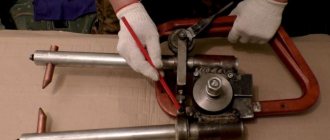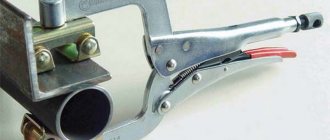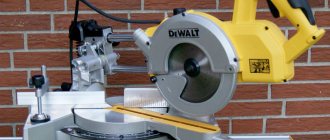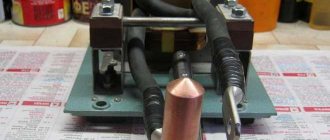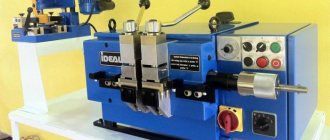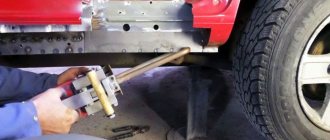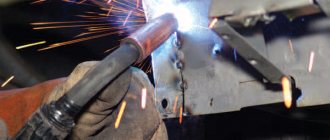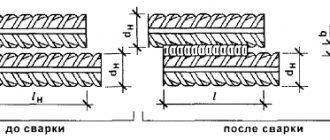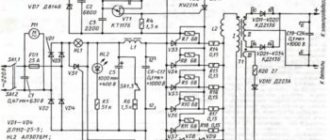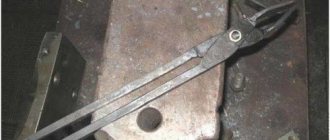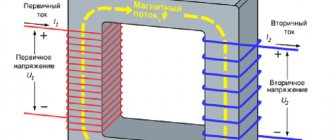The contact welding method is widely used in production and at home. In the process of welding metals, a high-power electric current warms up the welding site, and with mechanical compression a strong point connection is formed. Welding pliers simultaneously provide heating and increased compression of two metal strips.
Devices of various modifications can be seen in factory workshops and small auto repair shops. They quickly make strong spot welds in frame structures, cabinet products, air ducts, and various containers. The equipment does not require consumables.
Design and principle of operation
Any welding gun consists of five main elements:
- a power supply that provides the required power (a transformer copes with this task);
- starting device;
- two conductors connecting the power supply to the ends of the clamping device (pieces of cable with a large cross-section);
- two rigid conductors through which the charge flows to the point of contact (they act as levers of the clamping device);
- two dense electrodes that can withstand compressive loads and create an electric arc that heats the metal.
Welding pliers
Essentially, the design of the clamps is simple. These are the same pliers, the handles of which have wires connected to them, and electrodes are installed in place of the clamping plates. For power supply, powerful transformers are used, powered from a three-phase 380 V network. They are equipped with a solid copper disk of the secondary winding. The required idle potential difference is from two to five volts. The current strength of resistance welding, depending on the type of units, varies from 2 to 15 kA.
In order to weld metal tightly, you need a powerful arc. From it, at the junction of two overlapping sheets, a 2-3 mm fused point with a common crystalline structure is formed. For tight contact, the handles are compressed with the necessary force, which is why hand pliers are made with long handles.
Types of equipment
All welding guns work on the same principle: when current is applied, the electrodes are compressed. They differ in the form of fastening and the method of creating a force load. They come in two types:
- manual (they are light in weight);
- suspended (clamping arms are fixed on brackets or permanently placed on tables so that the contacts are suspended, the welder freely holds the parts to be welded in his hands).
Hand welding guns
Hanging welding gun
To create a large compressive force, suspended industrial pliers are equipped with a pneumatic pusher. If necessary, you can make hanging hand pliers; to do this, they are placed in a vertical plane. The lower handle is clamped in a vice, the upper one remains free. This design makes the work of the welder easier.
It is easier to squeeze welding clamping pliers by resting your whole body on the clamping lever.
Welding pliers selection parameters
To select welding equipment, you need to know by what parameters resistance spot welding units are evaluated:
- power characteristics: current strength and operating voltage, the heating capacity of the arc depends on them: it must correspond to the melting temperature of the alloys being connected (for a 4 mm connection, a current of at least 6 kA is required);
- the distance between the electrodes and the central axis of the welding tongs (the extension of the electrodes characterizes the depth of the tool’s entry onto the surfaces being welded);
- fastening the electrodes: they are fixed with clamp holders and a threaded connection (clamps are preferable);
- physical properties of electrodes (components of copper alloys affect electrical conductivity);
- productivity (measured by the number of joints made within an hour);
- weight of the welding machine;
- design solution: hand pliers or hanging pliers.
- The power of finished welding tongs ranges from 2 to 6 kVA.
What are welding pliers used for?
- January 05
- 48 rating
Welding pliers are the most common welding tool. There are many different connections, but it is preferable to use this option, because it has certain advantages. For example, there is no need to use professional equipment and resort to purchasing specific elements. The technology of the process itself is simple: a specialist is required to heat the metal using only electric current. When electricity is passed through a certain area to ensure welding, the products are connected to each other, forming a strong and reliable device.
Types of welding tongs.
Welding guns require the following conditions:
- High-quality preparation of surfaces to be joined. It is carried out even before the main work is carried out.
- Calculation of the electric current required to perform an action.
- The time during which the desired surface is impacted in order to quickly bond it to another object.
- The force with which it is necessary to compress the parts being welded for better adhesion.
In such a situation, resistance welding pliers are an excellent option, because only they combine all the necessary characteristics.
Design and principle of operation of products
The method of operation divides such devices into two main types:
Diagram of suspended welding jaws.
Hand-held products include a transformer that powers the electrode forceps. The front side of the case is equipped with a lever. It serves to adjust such a parameter as the width to which the holders open. The operation of the entire unit is carried out without the need to connect the electrodes to independent current sources using special wires. These resistance spot welding pliers are practical elements, because their weight is 12 kg.
The production of welding current by the product occurs precisely at the moment when it is connected to the electrical network. This phenomenon is immediately transmitted to the electrodes, with the help of which workpieces made of metal are clamped. Melting of the initial substance is carried out due to the influence of a large amount of welding current, and a welding point is formed in the place where the clamp was located. Excellent adhesion occurs due to the effective action of the electrodes, carried out on both sides simultaneously. The result is a reliable and practical connection that cannot be achieved using single-sided spot welding.
The use of hanging clamps often involves conditions where conventional products may not be suitable. For example, industry requires the availability of serious products, without which processes cannot be carried out. A distinctive feature of many products is their enormous productivity, thanks to which they can be used in completely different production areas.
Return to contents
Characteristics of welding jaws.
Buying a spot welding pliers starts with checking the maximum current value. The higher this indicator, the more likely the coupling of those parts whose size is very large. As an example, it makes sense to use hand pliers with a current of 3800 A. Their use leads to the connection of two sheets having a thickness of 1 mm. The maximum value of the parameter varies within 6300 A. Such figures make it possible to work only with those sheets whose thickness does not exceed 2 mm.
Factors such as the length of the brackets also play a big role when purchasing products. It determines how far the electrodes will fly out. This parameter is characterized as the length between the clamp body and the electrode. The indicator determines the maximum distance at which the edge of the sheet can be held when performing the process with your own hands. The parameter is characterized by a wide range of values (120-500 mm).
Return to contents
To form high-quality resistance welding, it is necessary to use specific welding attributes (electrodes), without which it is impossible to complete the process. For this purpose, it is best to use straight electrodes, which will allow you to create an ideal contact connection. They are made from thin rods with a diameter of 12-40 mm. The tails of such products can be of two types: in the form of cylinders and cones. Both are equally well used, because they should be fixed in a special socket for the handle using special clamps or tapered threaded connections.
Fastening of welding electrodes, which have a replaceable working part, is carried out using union nuts.
Such products are made using copper-based alloys, which have a fairly long service life and excellent performance characteristics. Copper is alloyed with chromium, cadmium, beryllium and other similar elements. Low electrical resistance and heat resistance make electrodes of this type indispensable assistants in any welding. They fully cope with the main tasks, creating contact when welding two different surfaces.
Return to contents
Homemade pliers for spot welding.
Assembling pliers for spot welding requires the owner to comply with all points of the plan, patience and perseverance. It is necessary to prepare a dart made of copper, having a length of 2 m, the diameter of which is 30 mm. These parameters may be slightly larger so that the product can be bent effectively. It is required to bend the dart so that it looks like the letter U. Each end of the product must have one hole with a diameter of 18 mm, which can be drilled. After this, the elements are unfolded and a cut is made. At the output there are two clamps intended for working electrodes. Transformers must be connected in parallel. For these purposes, it is best to use elements whose primary and secondary windings are directly connected, and the current strength is 9 A.
In any case, the current supply must be regulated by the owner independently, without the use of any third-party elements. Sometimes it makes sense to acquire a seven-storage switch that has a regular standby multivibrator that processes shutter speeds. You can create just such an element yourself, without even having to purchase some functional parts.
You can cool homemade pliers using water, and remove the electrodes using a foot pedal.
This option is not always suitable. Most people tend to minimize all functions, but often this is the optimal solution.
Hand-held welding pliers, whether made independently or purchased from a specialized retail outlet, include elements such as a transformer, a lever, a number of electrodes, and handles with a pusher. A special lever holds the hinges. During operation, their axes are in opposite directions, which facilitates the use of the entire unit and contributes to the formation of a high-quality and fast process. Sometimes the product includes a special spring located between the pushers to ensure a better welding effect. But such products are quite complex and impractical, because compressing the spring during some rotation is a difficult action, due to which the efficiency of the device is noticeably reduced.
All installation elements are extremely important. It must be remembered that the failure of a single component very often results in the inability to operate the entire system as a whole. Therefore, it is necessary to carefully monitor the serviceability of all functional parts of the created unit and avoid even the slightest breakdown.
expertsvarki.ru
Homemade resistance welding pliers
It’s quite possible to make spot welding pliers with your own hands. Step-by-step instruction:
- They make a clamping device. For handles, metal 20 mm strips up to 3 mm thick or metal rods are used. Two holders are bent from them, which are then fastened with a movable axial connection. For convenience, the connection point is equipped with an extension spring.
- They are thinking about attaching the electrodes. Welding pliers are equipped with bolted fastenings of replaceable electrodes on one side of the ends, and an electrical cord is connected to them on the other.
- A wire is supplied and attached to the handles with terminals. To ensure electrical safety, the handles are covered with insulating materials.
- The electrodes are ground out. They are made from copper or bronze rods, achieving minimal contact areas. Sometimes electric soldering iron tips are inserted instead of electrodes.
- Select a power supply. It is better to use a ready-made powerful transformer. If it is not there, instead of the secondary winding, attach three tight turns of cable with a copper core. Sometimes two transformers are connected in parallel, this allows the total power in the circuit to be increased.
- The device is equipped with a switch. It is more convenient to attach the trigger mechanism to the clamping handle. But sometimes it is mounted on the base of the box of the old device, in which case it is located separately.
- All connections are checked with an indicator; the homemade spot weld welding machine is ready for use.
Spot welding diagram
To make resistance spot welding yourself, carefully study the corresponding diagrams. The most popular of them is effective in situations where it is necessary to process metal sheets with a thickness of one millimeter or wiring and rods with a diameter of up to 4 millimeters.
In this case, it is necessary to take into account the following features:
- For welding, you should acquire equipment with an alternating voltage of 220 W.
- As for the output voltage type when idling, it is 3-7 V.
- The maximum welding current reaches 1.5 thousand amperes.
The entire design is characterized by a circuit diagram, which consists of power parts, an automated switch and a control circuit. If dangerous situations arise while performing a task, all you have to do to prevent them is press the switch. The first node is equipped with a transformer for welding T2 and a non-contact thyristor switch of a single-phase type, which connects the primary winding to an electrical power source .
As for the second scheme, it requires the implementation of a characteristic winding on the welding transformer using certain turns. On the primary winding there are lead-out sections, which are intended to adjust the output welding current taking into account the ratio of the secondary winding. Thus, the permanent connection of the network circuit remains at the first pin, and the operation of the power supply is regulated through the others.
An important part of the system marked M TT4 K is distinguished by mass production. This module contains a thyristor switch that switches the load through contacts 1 and 3. The device can operate under loads with voltages up to 800 watts and currents up to 80 amperes. The composition of the scheme includes:
- power unit.
- chain for setting the mechanism.
- relay k1.
Any transformer system with a power of up to 20 watts is used as a source of electrical power for welding equipment. At the same time, it is used when operating on a nominal network of 220 V. As for the voltage that is supplied on the second version of the winding, its indicators reach 22 V. To rectify the intensity of the current supply, you can install a diode bridge . The option of using any other nodes with similar parameters is also not excluded.
